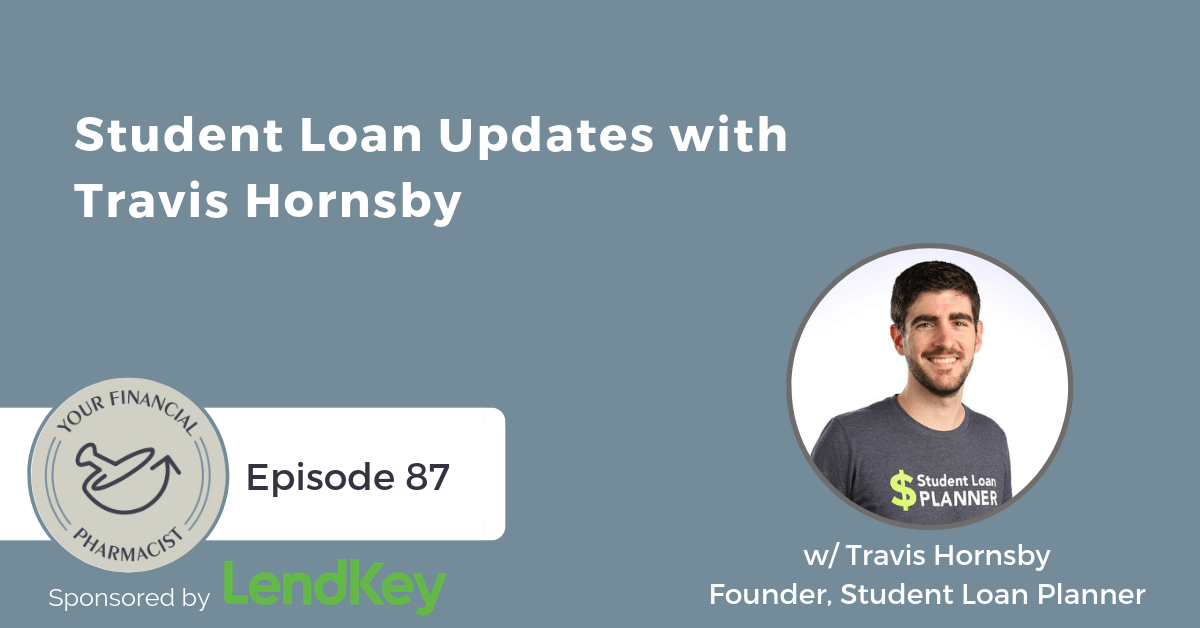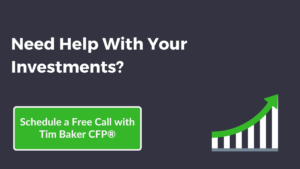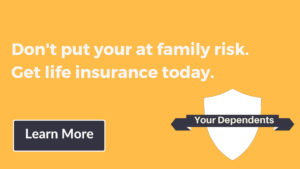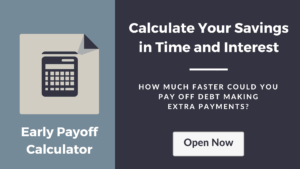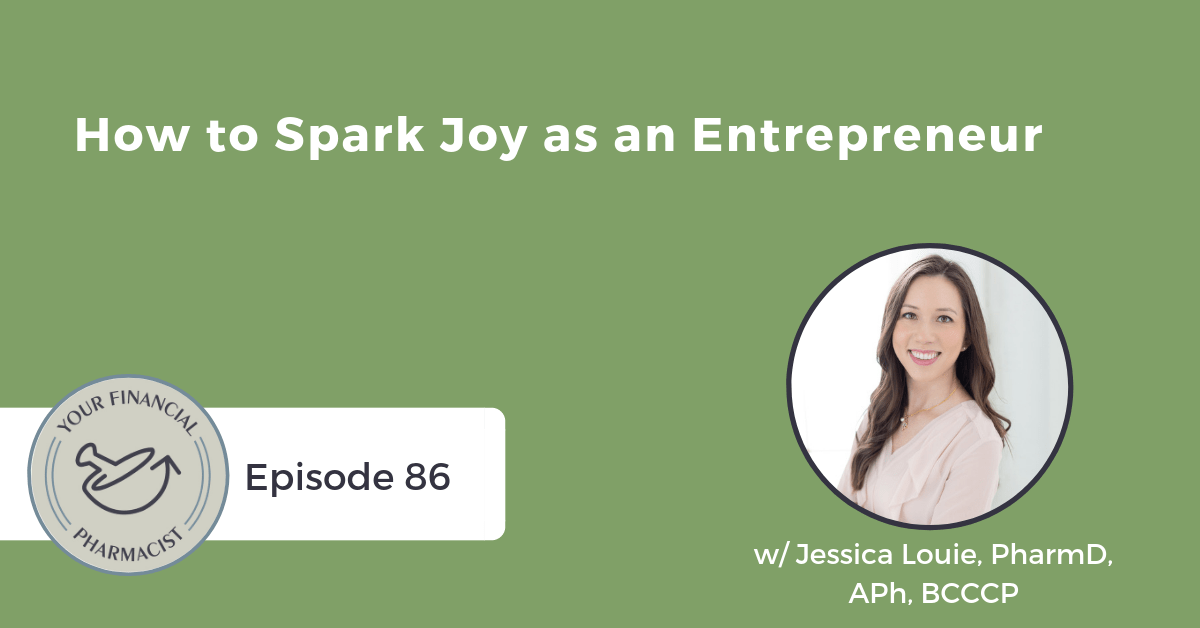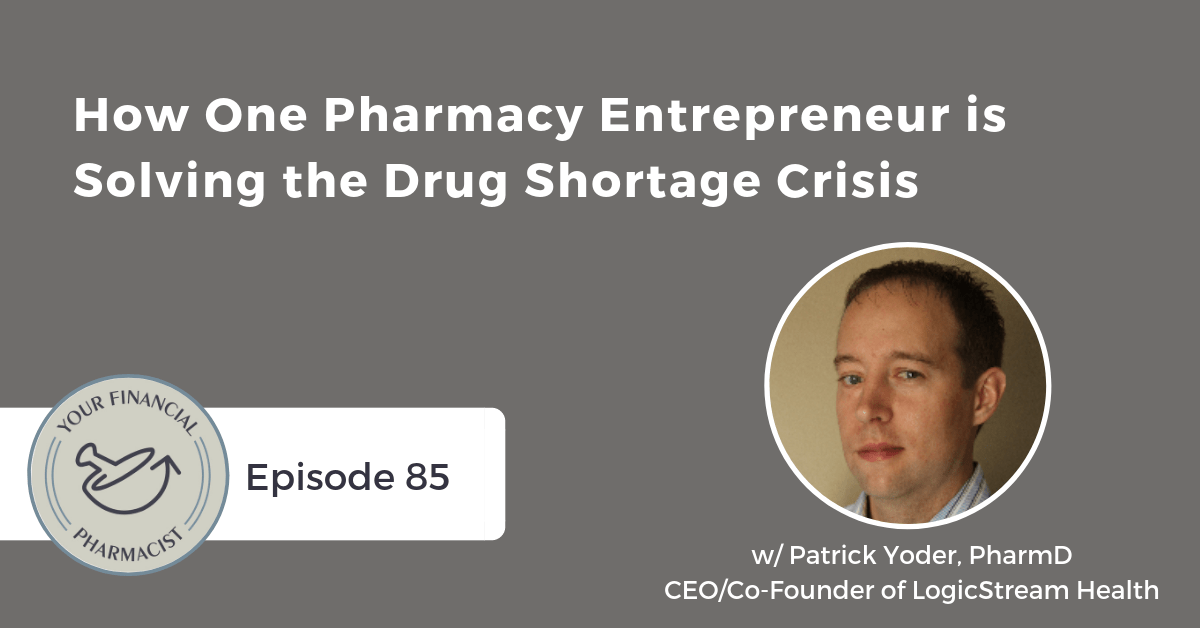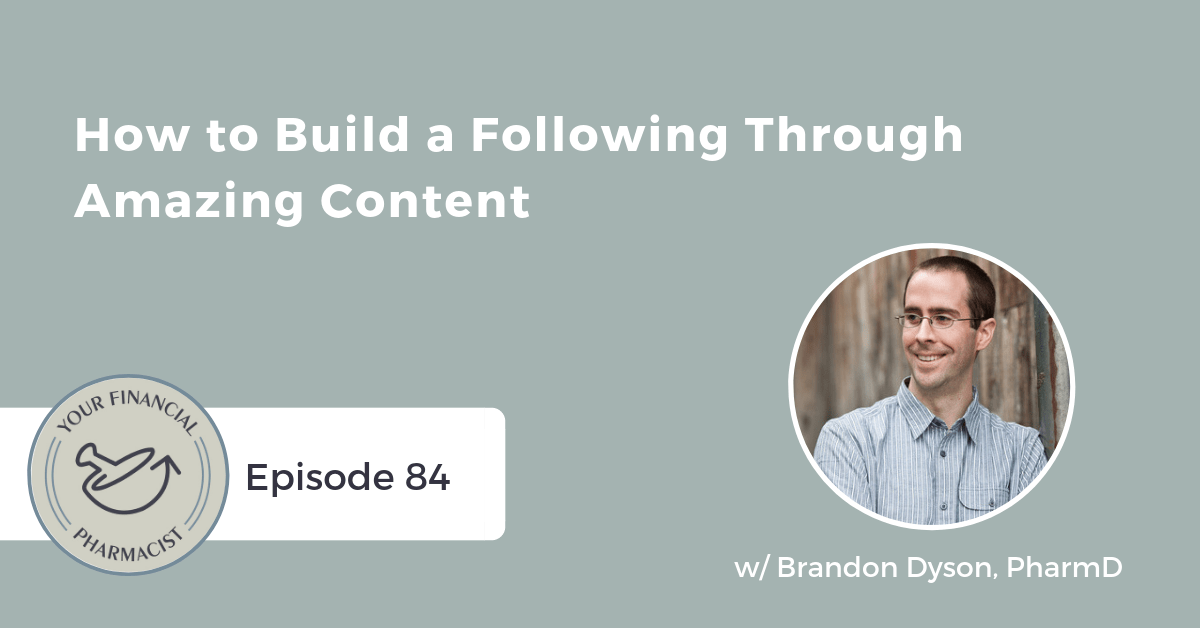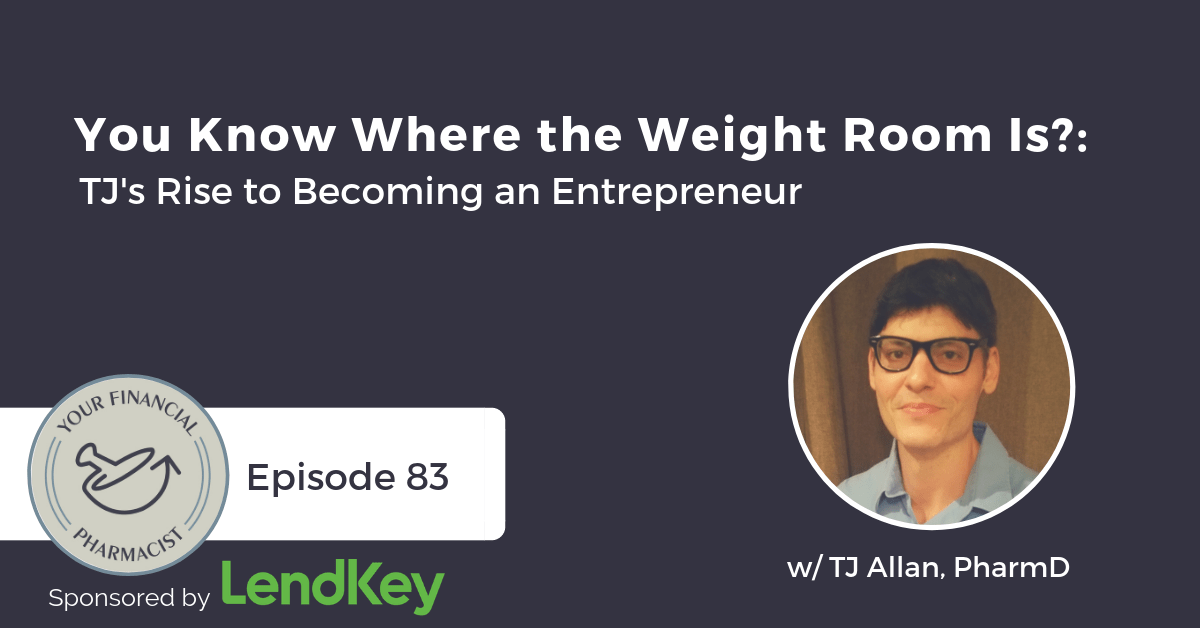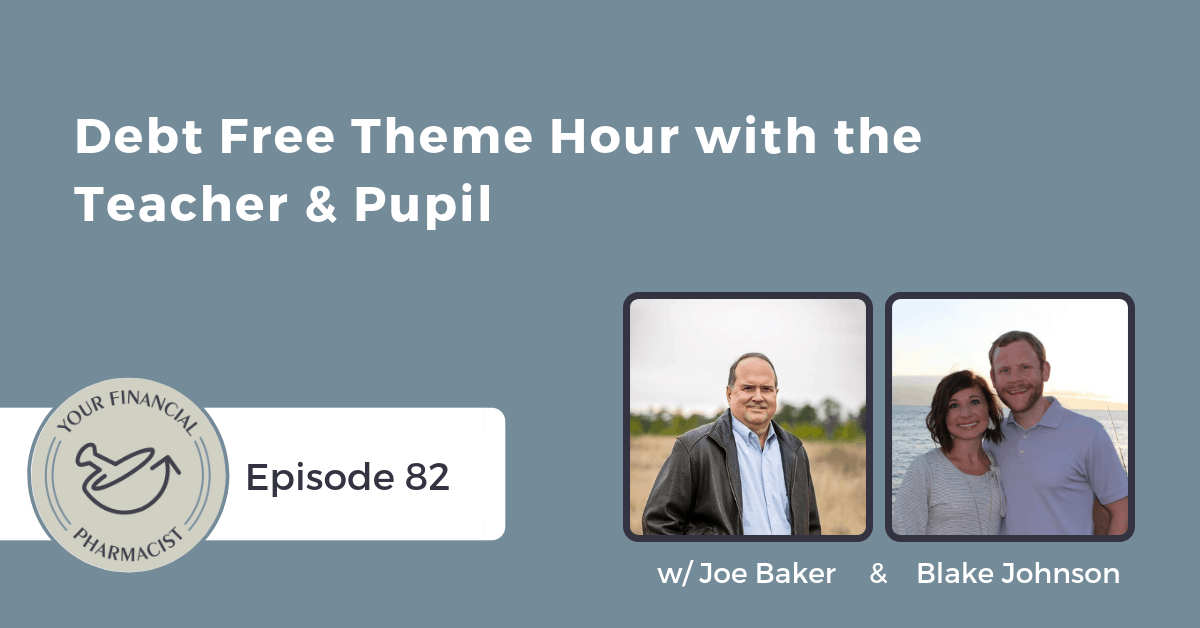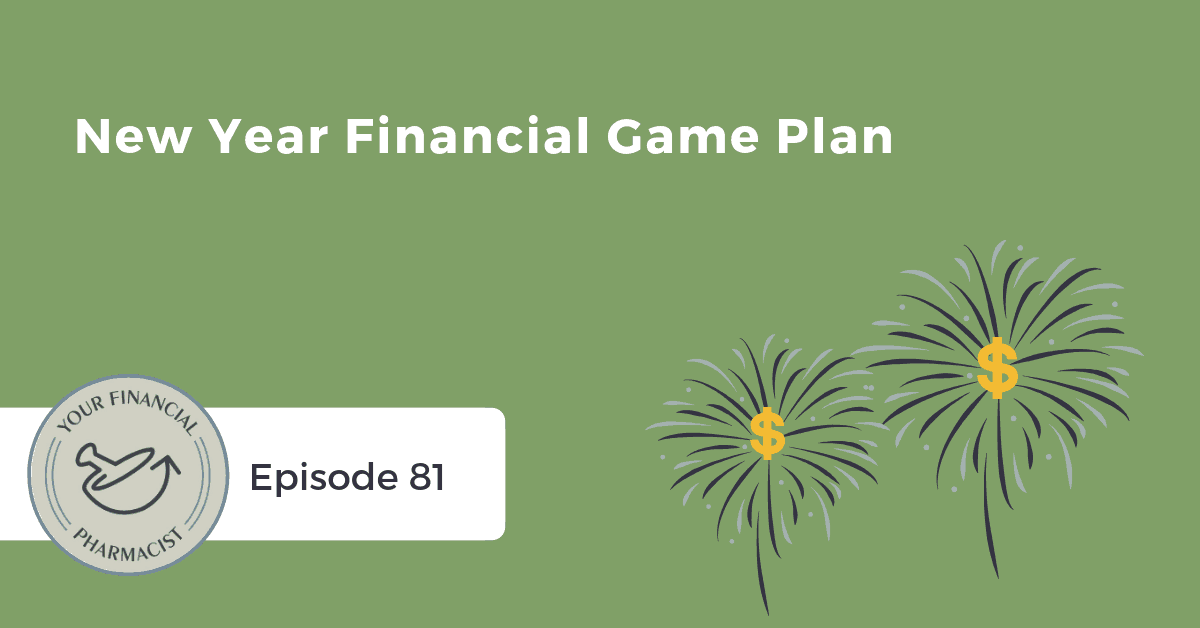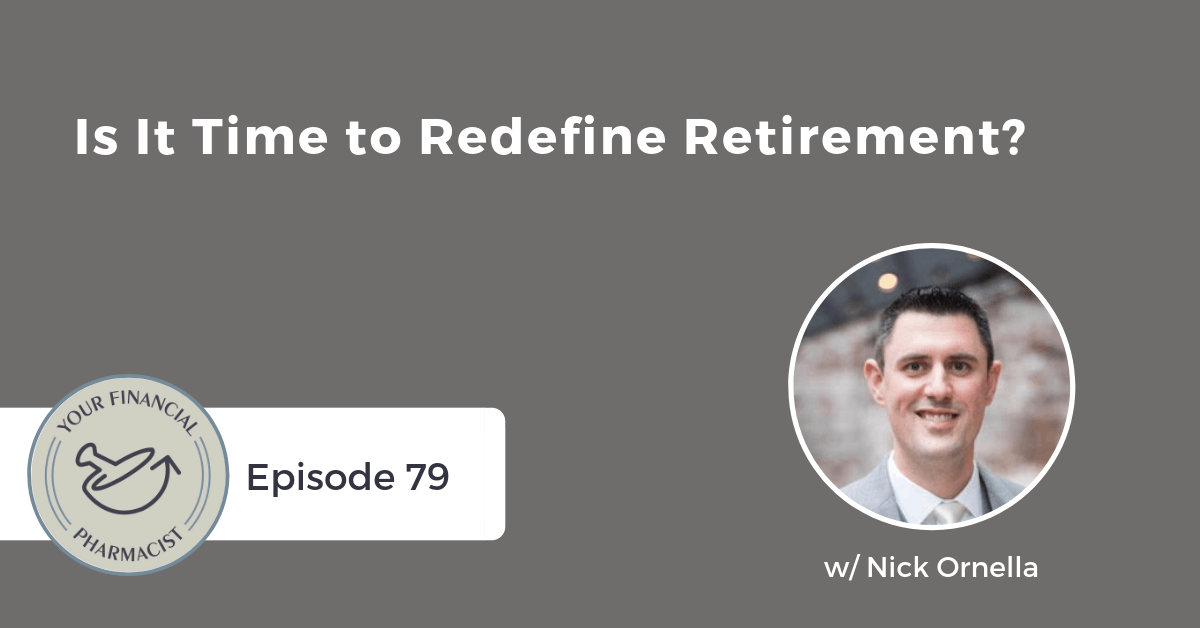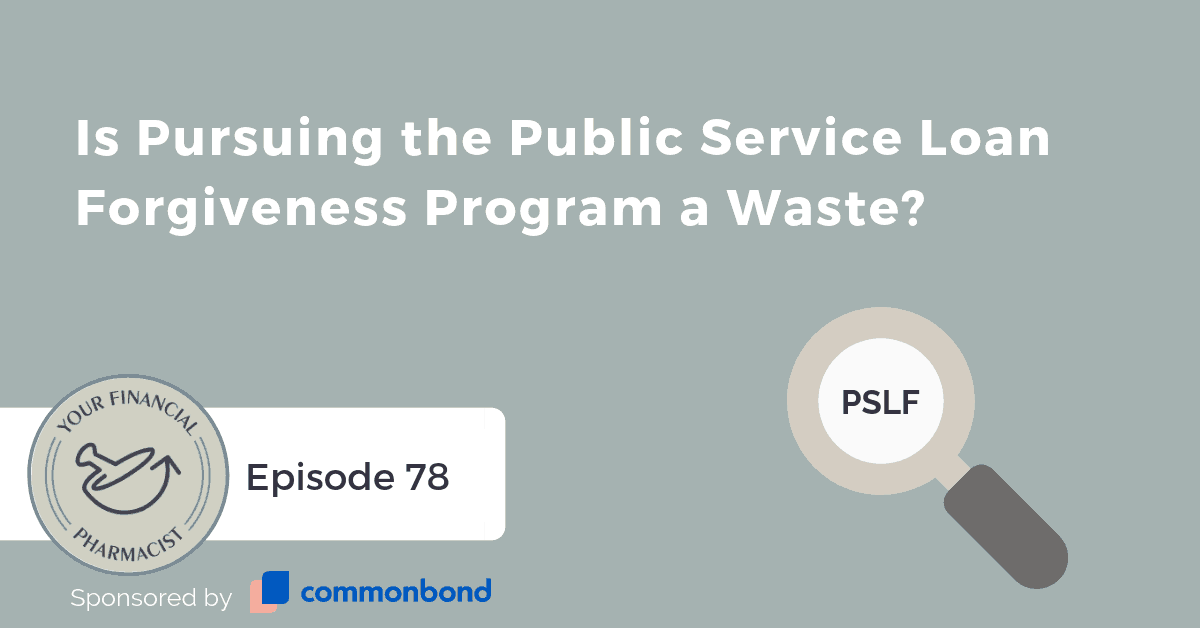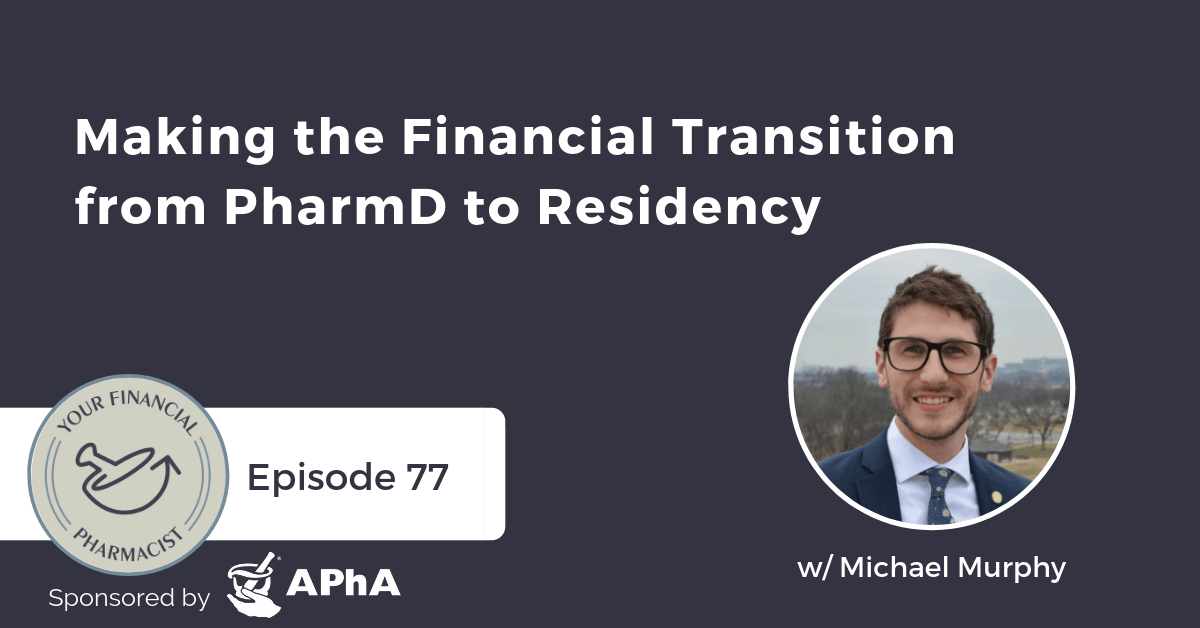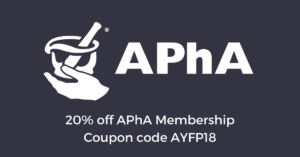Student Loan Updates with Travis Hornsby
On this episode of the Your Financial Pharmacist podcast, Tim Ulbrich interviews Travis Hornsby, Founder of Student Loan Planner and Chief Student Loan Planner. Travis shares student loan updates and talks about his journey starting the Student Loan Planner, the most common mistakes he sees pharmacists making with their student loans, the pros and cons of student loan refinancing, what legislative changes he anticipates will happen and the one step you can take today if you are feeling overwhelmed with where to go next with your student loans.
About Today’s Guest
Travis started Student Loan Planner in October 2016 after helping his wife and her friends figure out their six figure student loans. He used to be a bond trader, so he took his Excel heavy skill set and built models for how to save money paying back student debt. When he and his wife tackled her debt from med school, there were not a lot of resources out there for professionals like her. Most of the sites that did exist just wanted us to refinance so they could earn a commission.
Summary
Travis Hornsby, founder of Student Loan Planner, talks all things student loans with Tim Ulbrich. The Student Loan Planner has saved 1,500 clients a projected $80 million over the lifetime of their loans.
Before launching the Student Loan Planner, Travis worked as a bond trader for one of the world’s largest companies. However, he wasn’t excited about getting up for work in the morning. He sought early retirement, traveled the world, and met his now wife who had a lot of medical school debt. Travis used his experience with Excel to model paying off her student loans and did the same process later for a lot of their friends. This experience paired with his realization of how little or bad advice is given for paying off student loans led him to create his Student Loan Planner business.
Travis provides insight and updates for different loan repayment options and reminds those with pharmacy school student loan debt that they have a lot of options.
First, Travis discusses the Public Service Loan Forgiveness program (PSLF). He shares that a lot of people are getting the story wrong about the history and working of PSLF and thinks that in the future, borrowers taking this path will be grandfathered in to complete the program, even if the program has changed or doesn’t exist anymore.
Travis also discusses the return of investment of the pharmacy degree and that it’s important to take your focus off of debt and think about your broad financial goals, as this can aid in determining which repayment plan to chose. He also speaks about the refinancing market and how to know if that’s the option that will work best for your situation depending on your debt-to-income ratio. Travis talks about the benefits of the “refinancing ladder” and that you are able to refinance your loans multiple times.
He also gives advice to those that may be feeling overwhelmed by their debt. Travis shares that it’s important to determine what your goal is, whether it’s to get your student loan balance to zero or for your loans to be forgiven. This will help you determine which path to take and allow you to plan out how to repay your loans.
Mentioned on the Show
- LendKey
- Student Loan Planner
- YFP 018: Maximizing the Benefits of Public Service Loan Forgiveness
- YFP 078: Is Pursuing the Public Service Loan Forgiveness Program a Waste?
- Student Loan Planner Blog: TEPSLF Program: Lessons from a Reader Who Got Her Loans Forgiven
- YFP Community
- YFP Planning
- Student Loan Planner Podcast
- Email Student Loan Planner
- Student Loan Planner Blog
Episode Transcript
Tim Ulbrich: Travis, welcome to the Your Financial Pharmacist podcast!
Travis Hornby: Great to be here, thanks for having me, Tim.
Tim Ulbrich: Yeah, I’m excited to have you on and talk all things student loans and excited to be able to pick your brain as somebody I view to be a leading expert in this space and hear more about the work you’ve done at Student Loan Planner and also talk about this topic, this behemoth that is student loans, the impact on pharmacy graduates, what you’re seeing with your clients and the future of student loans. Specifically, we’ll talk a little bit about loan forgiveness, refinancing and other things that I know our listeners are in tune with or want to learn more about. And Travis, I have to say, I was reflecting as I was going back, preparing for this episode. I think it was just over two years ago I heard about your journey, we had a phone call, got a chance to talk a little bit about the vision of what we each were working on. And it’s been incredible to watch what you have been doing over at Student Loan Planner, so congratulations on the work that you’ve done.
Travis Hornby: Thanks, and you know, great work as well, educating pharmacists and making them more financially literate. It’s badly, badly needed. So really grateful for Your Financial Pharmacist being out there. We’ve got very similar positive missions to try to help people as a community, so it’s exciting to talk.
Tim Ulbrich: Absolutely. And before I ask you to talk a little bit more about your journey of starting Student Loan Planner, I want to make our audience familiar with the work that you’re doing if they’re already not, so StudentLoanPlanner.com, and you have saved over 1,500 clients a projected $80 million over the lifetime of their loans. And we’ll talk a little bit about how you have done that. And the website, again, StudentLoanPlanner.com, is an incredible resource: up-to-date information, you’ve got the blog, you’ve now got the podcast we’ll talk about here in a little bit, calculators, quizzes. Your calculators are phenomenal. Is that you building those? I mean, that’s amazing if you’ve been building those calculators.
Travis Hornby: Yeah, you know, I did build it. That’s my background, I was a bond trader for one of the world’s largest investment companies, and you know, the career path is keep your head down, make a lot of good trades, you’ll work your way up to being a portfolio manager, and that’s a wonderful career path. It’s a very numerative career path, but it just wasn’t for me. It wasn’t what got me up in the morning, really passionate and excited to go to work. And I’m a big believer that no matter whether that’s in your field that you initially chose or whatever it is, you should try to seek it out. And so for me, that kind of led me to trying to do early retirement. So I actually quit my job at 25 and traveled the world for a little bit and then ended up dating this woman who had a lot of student loan debt, my now wife. And she had a lot of debt from medical school, and so I was thinking, well, you know, I’ve got all these Excel skills fresh out of being a bond trader. I should use these to model it for her. And I did. And then she told me to tell all her friends about it because they were in the same boat. And then we had friends when we were up in Philadelphia that were in a bunch of different graduate programs, and I found that the math was applicable to their situations as well. And then I thought, wow, this is a lot more fun than making rich people richer. Not that that’s a terrible thing because a lot of big investors are mom-and-pop type people, and that’s a noble goal, but it just wasn’t something that made me super excited to help people that already had figured out their financial issues.
Tim Ulbrich: So Travis, what were you seeing at the time in terms of — you mentioned your situation with your wife and the journey that you guys had paying that off, and you’ve kind of brought your experiences together as a bond trader. You had this desire of kind of doing something you are passionate about. What did you see in your own journey as it related to paying off student loan debt and achieving that vision of becoming debt-free? And why were you then passionate about spreading that onto others?
Travis Hornby: Sure. So a lot of your pharmacists that are listening to this that work at not-for-profit or government employers will really feel the pain here, will really feel our pain. So my wife worked at a not-for-profit employer when she was in residency and in fellowship. So she had a bunch of credit towards loan forgiveness. And then at about year 7 or 8, you know, in terms of the numbers of years toward the 10 that she needed to get public service loan forgiveness, she submitted all the paperwork after I made her realize that hey, this is a thing, you should really apply for this, you should be eligible for this and then we should be able to just cap your payments out on the IBR plan for the last two or three years of it when you’re attending, and we should be able to get $100,000 wiped away. And so I submitted all the forms, and then Fed Loan came back to us and said, “You don’t have any credit on half of your loans. And on the other half of your loans, you only have three years of credit.”
Tim Ulbrich: Classic, right?
Travis Hornby: Yeah. I was just blown away by this. I said, how is this possible that you’ve made all these payments based on your income for seven years and you have almost no credit for a lot of your loans and barely any on the other half? So I thought that was just absurd, and so I ran the numbers again to see, well, pretend that she gets the full three years of credit on everything, what does that mean for the rest of the PSLF path? Should we count on this or not? And her debt was small enough, you know, thankfully, that we just decided that the projected savings, there might be like $20,000 or $30,000 left over at the end of the 10 years, so we’re just going to refinance it and pay it off really quickly. So that’s what we did. So we paid off her $124,000 of med school debt, which is, you know, very low compared to a lot of people that I talk to. And we’re very blessed that it wasn’t very high, but at the same time, it’s really crazy because it should be the injustice of this whole system going through this personally because her parents were first-generation Americans coming over here from Hong Kong and then Canada. And they really sacrificed and put tons of their savings into her med school to try to help her come out with less debt. And if she’d only had better guidance, she not only could have had her parents keep a lot of that money, but she could have paid even less of it back if she had had that information early on in the process. So I thought that was just so outrageous that one, the cost was already so high for medical school. But second, that she got such bad advice from that same medical school that caused her to be kind of taken advantage of by the loan services, just the fact that cost us five, even six, figures. I just thought that was terrible, and I didn’t want that to happen to anybody else.
Tim Ulbrich: I love that you took your personal pain and obviously, you know, nobody wants to go through that, but taking that personal pain and turning it into good and teaching others. And I think as I follow your blog, I weekly kind of follow, I think you’re an incredible teacher of taking what is a unbelievably complicated subject — probably one we both agree is unnecessarily complicated — and really breaking it down in a way that people can understand and really take a step back to say, what is the best student loan repayment option for my personal situation? And I know coming out of school, similar type of a journey, as I look back, I could have went Public Service Loan Forgiveness, I could have refinanced, didn’t know what either of those were, didn’t have the education, didn’t have the tools. I couldn’t tell you what was subsidized, unsubsidized. I couldn’t tell you IBR and PAYE and REPAYE. I didn’t have any idea any of that knowledge. And I think that’s a consistent theme we see with lots of pharmacists, I’m sure you see with your clients, and being able to break that down and as you work with people one-on-one to say, hey, based on your situation, this is really what we think is the best path forward I think is incredible. So that’s been fun to watch your journey and see that grow along the way. So let’s talk while we’re in the moment of loan forgiveness, let’s talk about that for a minute because I think there’s so much swirling right now about Public Service Loan Forgiveness. We’ve talked about it on this podcast on multiple occasions. In Episode 018, we talked about maximizing the benefits of PSLF. Episode 078, we just recently talked about whether or not pursuing loan forgiveness is a waste. And so much news swirling around about, you know, at 99.x% of applicants being rejected and you know, is this something as a new pharmacist graduate that might actually be viable for me or not? So give us the lowdown on what’s going on with loan forgiveness. Is there any new news out there? What should recent graduates be considering as they potentially pursue this path?
Travis Hornby: Yeah, that’s a great question. So the listeners that are planning on loan forgiveness or afraid that they might not get it, they first need to realize historically what happened with this proram. So this program was around since 2007 on the books but functionally, it really didn’t exist until like 2009. And in earnest, it didn’t exist until 2010. And the reason is because you had FFEL loans before 2010 that were basically loans issued under an old loan program. So before 2010, when the government took over all student loan lending and created everyone had to use the direct loan program past that point. Prior to that point, you had this FFEL loans, which are basically bank loans that are backed by the government. And those loans, because you can think of the banks being the ones that actually hold the debt, obviously they wouldn’t want those loans forgiven, right? And so the government essentially gave them basically allowed the banks to not have to deal with the PSLF thing for those loans. And so when 2010 rolled around, then everybody started getting direct loans by default without having to do anything special. And everybody had access to things called Income-Based Repayment that people could sign up for without having to be a PhD-level expert in Department of Education bureaucracy. So a lot of people look at these statistics, and they get really depressed. But the problem with that is that you have to look at what happened 10 years ago to understand why so few people are getting approved today. And that’s a very hard thing to do and explain in a quick 800-word article on CNBC or something like that. So that’s the problem is a lot of people are getting the story wrong because yeah, like it was almost impossible to have loans that qualified in 2008 and 2009. That’s why you’re only seeing people that basically went to like one-year Master’s degrees that documented everything perfectly, they got super, super lucky being the ones that are getting approved right now. And so for that reason, I don’t personally believe that we’re going to see any large-scale forgiveness for PharmDs until about 2023. I think that’s when we’re going to see the first cohort that had been on an income-driven program for, you know, 10 years consistently and actually has a full slate of PharmD debt that they’re going to get forgiven. So a lot of the people out there that are pharmacists, you know, don’t expect any shocking news until then.
Tim Ulbrich: And you actually recently talked with — or I can’t remember, you might have blogged about it — a real, live person who actually had loan forgiveness, right? I mean, they do actually exist.
Travis Hornby: They do. Yeah, it was great. She sent me an email — that’s one of the best parts of having a student loan blog and just being super focused on that alone is, you know, I got this long email from this person who was like, this is my story. Feel free to use it. And I was like, absolutely. I’ll take you up on that. So I wrote a blog post about it, and she only had $19,000 from a very short, abbreviated degree program in like 2008 that just happened to be from one of the right schools. Because they had direct loans prior to 2010, but it was very limited. And so this person just happened to have the right kind of debt, she had signed up for the wrong kind of program, but she followed the TEPSLF rules, the Temporary Expanded PSLF rules, precisely. And she ended up getting loan forgiveness, and it was amazing. She even got refunds for all of the payments that she made that she shouldn’t actually have to make based off of her payment count. So that’s really amazing. Like anybody that’s worried about not getting PSLF needs to probably read that article because it shows you that not only are they going to cover it and give it to you, they’re also going to give a literal refund for all of that money that you pay that you shouldn’t have had to pay. So that’s the most amazing program that you can really think of in terms of if you can actually get it.
Tim Ulbrich: So one of the questions I probably get most often, Travis, is what is the future of this? And what certainty, if any, what’s the political climate? And obviously, none of us have a crystal ball, but as you’re in this each and every day in the weeds, I mean, do you foresee major legislative changes coming in the future? And if so, should there be any security that people feel in terms of being grandfathered in in terms of when those rules may be changed?
Travis Hornby: Yeah, so the thing that people need to realize is the way that the U.S. government works is the grandfather people in, and they make changes on a long-term basis. So a perfect example for this is social security. Social security, whenever they need to fix the program, they don’t cut benefits for people that are currently retired because they don’t want to make people super angry at them in the short term. So politicians is the “them” that I’m talking about. So what they do is instead, they just gradually raise the retirement age over time. So if you talk to people that are looking at social security, their retirement age goes up by like I think it’s 2 months every year or so for the next x amount of years until it hits 67. So something similar like that’s going to happen, I think, with PSLF. I think that it’s very, very expensive, this program. People have no idea how expensive it’s going to be from the taxpayers’ perspective. So I do expect it to get phased out eventually. I think that you’re going to a future Congress realize that it’s way, way more expensive than they thought probably in the early 2020s, and then I think that they’re going to probably curtail it or eliminate it, but they’re going to eliminate it for future borrowers, and they’re going to eliminate it for people who start graduate school after a certain point. So it’s going to be real interesting to see what grad programs do. I would imagine they’ll probably try to enroll a lot of people early. You know, so they can get access to this. But yeah, I do think it’s going to end at some point in the next, say, 5-10 years. But I think it’s going to end for people who have never taken out yet. So I think that the PSLF promises that are being made now will be continued to be paid out well into the early 2030s.
Tim Ulbrich: Awesome. I’m going to switch gears for a minute here and talk about the ROI of the pharmacy degree. You’ve blogged on this topic, and we’ve talked about it here. We’re in a landscape that is shifting. We’re hopeful, I think, as those that love the profession we’re going to see this shift back, but obviously supply-and-demand, and actually just yesterday, I got an email from somebody in the YFP community talking about they’re a fourth-year graduate, getting ready to go out into the market, they’re worried about the market being saturated, salaries are decreasing, and they’re basically looking at between salary reductions and a reduction in the number of hours, planning on a base salary somewhere around $85,000. And the question being, what can I, what should I be doing to plan financially for that? And I think historically, the message that I felt and many others have felt that don’t worry about the student loans, you’re going to have a great income. Well, that story is changing. So as you’re working with clients, Travis, specifically your pharmacy clients, are you seeing this trend? Are you seeing the shift? And what are some of the things that you’re trying to help them think about in terms of intentionality of student loan repayment? Maybe being strategic about finding an employer that qualifies for loan forgiveness, refinancing, how does this shifting ROI of the degree in the job market impact their plan to pay back student loans?
Travis Hornby: Sure. So the average pharmacist client that we’ve had has had about $214,000 of student loan debt. So that’s obviously a multiple of what the first-year starting salary is. If you were going to talk about the average income being $85,000, then in terms of the average that we’ve seen, that would a debt-to-income ratio of about 2.5, 2.5 times income. So generally, what we tell people is if you have a debt-to-income ratio that’s above 1.5-to-1, and this is at a family level, then that means that you probably need to go for loan forgiveness, you know, in some fashion. Basically, what you need to realize is that if you try to refinance this thing, it’s kind of like walking in front of a train. If you’re making $85,000 a year, you have $200,000 in debt, you’ll have to pay $2,000 a month for 10 years. So that’s about a third of your take-home pay going to debt. That’s really not that sustainable.
Tim Ulbrich: For 10 years.
Travis Hornby: For 10 years. That’s really not a sustainable or a smart decision. And that’s not anything, that’s not a mean statement, that’s just reality of math. And you could pay the debt back, but if you do, then you’re not going to be accomplishing things like saving for retirement, saving for your kids’ college, you know, buying a house, like doing all these other financial goals that are really important. So one thing that I like to tell somebody is take your focus off of the debt from a really zoned-in level and start thinking more about, you know, what are your broad financial goals? And how does that fit into your debt repayment? So for example, if somebody has $120,000 in pharmacy school debt and they are one of those lucky folks who does get a full-time job at a CVS in maybe a rural location making $120,000-130,000 a year, yeah, sure. Refinancing can make a lot of sense. And paying it back in five years and doing a refi ladder where you start with a 10-year, refi to a 5-year later, you know, and getting rid of it as fast as you can, that’s a great decision. But when you’ve got an $85k type of income, I’m assuming that this person’s not working at a community hospital or an eligible not-for-profit. So that’s one of the biggest misconceptions that I’ve run into with pharmacists is they’re not aware of the other loan forgiveness. So the IDR loan forgiveness. And that’s going to be more and more important for pharmacists. You know, one thing that I think is fascinating is $85,000 is still an amazing salary. That’s still really good compared to your typical person that’s going to go work for a corporation and make $50,000-60,000 a year. And if you’re working 32 hours a week for that income, that’s exceptional. And the reality is I think we’re going to continue to see, you know, this decline in salaries because of the acceptance rate of pharmacy schools is so high overall. And so I think for a person who’s in pharmacy school now, you think about this from a positive perspective is the worst case scenario, your debt is a tax. It’s a percentage of your income. And so if you lose 10% of your income to student loans, and that’s your cost — I know you have to put a couple hundred dollars away for a tax bomb one day — then that $85,000 income can actually be pretty attractive. And to take it a step further, you know, how many people out there can go earn a $50,000-60,000 a year job or salary, rather, working 20-25 hours a week? Not a lot of people.
Tim Ulbrich: Yeah, I think that’s great insight. And we’ve talked before on the show, and I want to emphasize it again because I don’t think we talk enough about what we call non-PSLF forgiveness, or the other PSLF forgiveness. And I think you’re spot-on with this debt-to-income ratio, if that continues to trend in the direction we’re seeing it trend, that option is going to become all the more important as when you evaluate. And I also would add to that, Travis, and we’ll talk here fo a minute about refi, but as interest rates are climbing, obviously, that changes the math a little bit on the refi. And I like the example that you used of pharmacists coming out, maybe they have a lower debt load than the average, so maybe $110,000-120,000. Maybe they’re making $120,000-130,000, they’ve got one of those full-time jobs that’s paying a decent salary, well then obviously, paying them off or refinancing looks very different than somebody maybe who has $250,000 of debt and they’ve got an $85,000 income. And to Tim Baker’s credit, one of the things he talks a lot about, and I appreciate his external view into the pharmacy world is that we typically don’t think about career advice in the sense of seeking something like a qualifying employer for loan forgiveness, right? We often are thinking about it specifically on the type of pharmacy practice that you’re interested in, salaries have been relatively equal since I graduated in 2008. You aren’t seeing huge discrepancies from one area to another. But we are starting to see that trend happen. And I think now, a very important consideration is if you’re somebody that has an extremely debt-to-income ratio, then really that choice of employer and potentially being able to pursue Public Service Loan Forgiveness is going to be a viable option. So Travis, as a follow-up to that, what are the trends you’re seeing in the refi market? It feels to me that six or 12 months ago, even maybe a year or two years ago, the math on that was very lucrative because of where interest rates are. And I feel like that’s tapered off a little bit as interest rates have come up. What have you seen in terms of the clients that you’re working with?
Travis Hornby: Yeah, I mean, a few months ago, that was definitely the case. It’s gotten a little bit better because the 10-year Treasury yield has declined a little bit again with a little bit of uncertainty in the economy and the government shutdown, China’s economy being a little bit slower growth than expected, so I think that the refi opportunity will exist for at least probably the next few years. I’m not sure if it’s going to go completely away. I don’t think it will because, you know, a reminder for folks that when you borrow in school, it is tied to what the government’s borrowing cost is. So you know, eventually, if interest rates keep rising, you will also feel it in your student loans that you’re taking out while you’re in school. You know? So last year, Grad Plus was 7%. This year, it’s 7.6%.
Tim Ulbrich: Ugh.
Travis Hornby: Yeah, so even though you might not be able to refi to like a 4% or 4.5%, you know, if you can still refi to like 5-5.5%, and you’re having to borrow at 7.5% or 8% or 8.5%, like that’s still savings, you know? But yeah, the refi market, I think the one thing that I’d like people to know more of — and we have a similar philosophy too on how we hook people up with the refi deals because you guys obviously have a lot of great bonuses on your site — and the thing to do is to refinance multiple times. So I did a survey of our readers, had almost 1,000 responses, and only half of them knew that you could even refinance more than one time.
Tim Ulbrich: Yeah, we see that a lot too.
Travis Hornby: Yeah. So for example, like you can refinance for — say you’re one of those people making $130k and you have $120k in student loan debt, well, you don’t want to do a five-year because that payment’s going to be over $2,000 a month, and what if you lose your job? What if you want to move? What if you want to work part-time or something like that happens? So that’s a very common feeling. And so rather than jump right into a five-year, what you can do is you can do a 10- or a 15-year where the payment’s around $1,000-1,300 a month, something like that, and you can pay extra. So you can pay maybe $2,000-3,000 a month to really knock the debt down. And then once you knock the debt down a bunch, then you can refinance it again and maybe cut your 4.5% or 5% rate down to maybe a 3.5% or 4% rate with about the same monthly payment by refinancing to a shorter term. So that’s called a refi ladder, and a lot of people don’t understand that. And that’s something that could save people money. I will say this, though, the refi thing, I don’t want people to get super focused on the refi thing because that will save you several thousand dollars, it really can in terms of interest costs. And if you pay down your debt faster than you would otherwise, it could save you tens of thousands. But loan forgiveness can save you hundreds of thousands in certain situations. So that’s why, you know, you’ve got to be real careful also about not making extra payments. One problem that I see people make or one mistake that I see people make — I’ll give you an example. I had a buddy who was a community pharmacist at a hospital system, and he was paying on the standard 10-year plan. So he was paying on $200k of debt about $2,000 a month, you know, instead, he could have been on the Revised Pay As You Earn plan, and he could have been paying about like $690 a month. So you know, saving almost a little over $1,300 a month, and he was eligible for Public Service Loan Forgiveness.
Tim Ulbrich: And maxing out a retirement account and all of that jazz, right?
Travis Hornby: Yeah. And then he could reduce his student loan payment even more. So and that’s the PSLF example. You know, the flip side to that is a pharmacist who wants to have a family, work 20 hours a week, wants to have more time for hobbies or whatever that reason would be. And then that person can pay, you know, say $400 a month working part-time. And then you just have to make sure you’re prepared for that tax bomb when it hits in 20-25 years.
Tim Ulbrich: So I hope the students that are listening, hopefully one of the take-home messages you’re getting as you’re hearing Travis drop lots of wisdom here is knowledge around this topic is obviously going to be able to influence a decision that could save tens if not hundreds of thousands of dollars. So using this time, you know, before you graduate, before you go through the grace period, to really identify for your personal situation, taking a step back, looking at all of your financial goals, looking at the type of job you’re going to pursue, residency, no residency, all these variable, debt-to-income ratio, and coming up with the best student loan repayment option is huge. Refi ladder, Travis, I like that. I know the concept, we talk about it. We talk about that idea, but I think you should brand that. So I haven’t heard that term used before.
Travis Hornby: Yeah, I should trademark it, right?
Tim Ulbrich: Absolutely.
Travis Hornby: I got a lot of zingers here, you know? I mean, yeah. There’s all kinds of weird things that I’ve learned doing this that you wouldn’t think about unless you’ve really had a lot of cases. So I’ve done over 1,000 plans personally. I think that’s more than anybody else in the country. I’m not positive, but I think that is. And you know, advised more than 330 million myself.
Tim Ulbrich: That’s incredible.
Travis Hornby: Yeah, so that’s pretty bad because that tells you how much debt it out there, you know?
Tim Ulbrich: Well, you’ve got $1.what? $1.4 trillion more to go? Something like that?
Travis Hornby: Yeah, exactly. So I mean, so one example is something called the breadwinner loophole, that’s another one of my weird terms I’ve come up with. So for example, a pharmacist in California might be making $90,000 a year, maybe she has a stay-at-home spouse, and that spouse makes nothing. And she’s eligible for Pay As You Earn. Well, in community property states, you can file separately for taxes and equally distribute income. So you can equally distribute income based on community property rules in these certain states. There’s like nine of them. And then you can basically have instead of an income of say $90,000, her income would be $45,000. And because you equalize the incomes, you also eliminated most of the tax penalty from filing separately as a married couple. So that’s an example of just some random thing that, you know, we realized probably a year into doing this that people could do since the payments are based on your adjusted gross income. And you know, we’ve not received any guidance on this yet, but it certainly seems like this is a legitimate way to approach repayment in these nine specific community property states. So that’s another one of these random things that you wouldn’t really think about unless you do this all day, every day. So that’s one thing that I like about our focus is we really do focus just on people that have $50,000-$1 million of student loan debt. Really, our primary client is in the $200-500k range. But you know, it lends itself for having a deep specialty level of expertise on something that’s very complicated. You don’t have to worry about getting the broad financial plan together, the insurance or things like that. That’s somebody else’s job.
Tim Ulbrich: Tim Baker, that’s your job. Yeah.
Travis Hornby: Exactly, yeah.
Tim Ulbrich: What are, Travis, some of the most common mistakes that you’re seeing pharmacy graduates make as it comes to their student loans? I mean, I’m sure there’s a ton of them. After you do enough of these, you start to see some I’m guessing repetitive things that are happening over and over again that our listeners can be aware of.
Travis Hornby: Well, for your pre-pharmacy listeners, there’s a whole bunch of schools that have opened up to basically take your money. And that’s why they exist. I mean, that’s just my personal opinion. But you know, you have like high-quality schools, you know? Like UNC or like Ohio State, that’s where you’re at, right, Tim?
Tim Ulbrich: Go Bucks. Yes.
Travis Hornby: Yeah, so maybe University of Florida. I mean there’s pharmacy schools that have been around for a long time that are high quality that even if you have a crash in the profession are not going to be going anywhere. But there’s a whole bunch of new schools that I won’t mention any by name because you know, I don’t love getting served lawsuits, but you know, basically there’s schools that were initiated that are private schools that were founded in the past, you know, 5-10 years I would say are automatically suspect. It doesn’t necessarily mean it’s a bad school, but you want to be very careful. And from a student’s perspective, if you’re going to go to these places, you just have to realize that things could potentially not end well if you go to one of these programs that has a high acceptance rate. So I would actually ask the school to give you their acceptance rate data. I would ask them to tell you what their average salaries are for graduates in writing. And I would actually do some due diligence and actually ask them in a very assertive manner for these statistics that you deserve to have prior to making this decision. Now, if you already have the debt, then I think that your perspective has to be a positive one. There are, like I said — you don’t even have to actually be a pharmacist, which is kind of crazy. These income-driven repayment plans apply whether or not you’re unemployed or making a bazillion dollars as a CEO. So it doesn’t matter that you become a pharmacist, even if you graduate pharmacy school. So from a mental health perspective, don’t feel trapped, even if you have $200,000, $300,000, $400,000 of pharmacy school debt. Do not feel trapped. You have so many more options than you think you do. And if you want to go make 50% more than the median household income in America, you can do that, even in a big city and live a pretty decent life. You’ll have to live on a budget, you’ll have to be a little careful with your expenses. It’s not as good as it used to be, but you’ll certainly make a good living. And so I would just say in terms of student loan mistakes, I mean, it’s a little broad, but I guess I just want people to know that the biggest mistakes you can have is not having a plan and sticking your head in the sand.
Tim Ulbrich: Amen. And if I could echo that, that’s the one thing we’ve seen, Travis, is the wandering through graduation into new practitioner life of not having an intentional plan. We’ve already highlighted and we don’t need to beat it further that that can cost you hundreds of thousands of dollars. And that example you gave of I think you said it was a community pharmacist friend of yours that went through a 10-year standard repayment, paid the maximum payment for 10 years, that was my situation. You know? And I think that as I look back on that journey, a little bit of knowledge would have saved me a ton of money along the way. And I want to also add, you know, your advice for the pre-pharmacy student I think is incredible because the reality is not all schools are created equal. And a lot of this data you can go out and look up in terms of what’s the board pass rate? What’s job placement like? What is the application acceptance rate into the College of Pharmacy? What’s the residency placement rate? And obviously, you know, there’s ranking that are out there, but they don’t represent many of the factors that are going to be most important to you as a graduate of a pharmacy school. So great stuff there. Travis, my last question for you is that my guess — just knowing our audience — is that we have lots of our community listening that’s feeling stuck with their student loans, feeling paralyzed, maybe feeling overwhelmed, don’t know where to start. What’s one piece of advice that you’d give to them that they can begin to get over that hump of feeling stuck or overwhelmed?
Travis Hornby: One piece of advice would be look at what your payment is. If you think that your payment is too high, take a look at Pay As You Earn or Revised Pay As You Earn and try to figure out whether or not your end goal is to go for full repayment and get to $0 in terms of the debt you owe, or if it’s to go for forgiveness. That would be the first big decision somebody has to make. So if you could at least figure out whether or not you need to go for forgiveness or repayment, that will help a lot because a lot of people, you can tell that in their actions, they don’t really know. They’ll throw an extra $200 at their highest interest rate loan when they have it, they’ll make a $5,000 one-time, lump sum payment to the smallest loan to get rid of it so they feel better psychologically, and that’s very, very indicative of just having no plan and no strategic direction at all with your loan repayment. So I would say that’s one piece of advice. One thing that I’d say is I forgot to say this when you asked student loan repayment mistakes. There’s a lot of residents out there who probably listen to your podcast.
Tim Ulbrich: Yeah.
Travis Hornby: The residents need to be on one of these income-driven programs while they’re still in residency.
Tim Ulbrich: And not deferring.
Travis Hornby: Yeah. A lot of people don’t realize that, but if your goal is to eventually pay your debt back, Revised Pay As You Earn can get you thousands of dollars in interest subsidies from the first month that you start paying on it. So if you’d like to have $5,000-10,000 less in debt by the end of your PGY1, PGY2 years, then get onto the Revised Pay As You Earn if your plan is to eventually pay the thing off. If your plan is not to eventually pay it off, you’re kind of unsure, then you might look at Pay As You Earn as well to try to build up credit for forgiveness. But that’s one mistake that I see people make all the time that I think people will continue to make because, you know, the residency programs are not as organized with as much detailed information for loan management as I think a lot of the human medicine physician type residency programs are because they’re a lot older and more resources are behind them. So that’s one thing that I’d say for your residents listening, but yeah. The big kind of direction, you know, you have to figure out if you’re going for full repayment or forgiveness. And that’s the big fork in the road, and that determines a whole bunch of the recommendations that we like to give. So like one thing we do is we figure that out for people or which path we think they should go down.
Tim Ulbrich: Yeah, great advice for residents. And I probably see — the most common situation I see is deferment during residency, which for those that are thinking loan forgiveness, obviously deferment does not equal a qualifying payment, number one. But two, as look at the income-based repayment plans, then you know obviously depending on how that’s calculated, you know, there’s this automatic assumption that I can’t afford any payment. Well, do the math. Sit down and figure that out. And obviously, you’re going to begin to make that progress toward whether you’re going to pay them off and refinance them or whether you’re going to eventually pursue loan forgiveness. So Travis, obviously StudentLoanPlanner.com, our listeners can learn more about the work that you’re doing and the service you provide. Also, it’s my understanding you recently launched a podcast, the Student Loan Planner podcast. I’m assuming that’s available on iTunes, anywhere that you can find podcasts: Stitcher, Google Play, Spotify, etc. Beyond StudentLoanPlanner.com and the podcast, what’s the best place that our listeners can go to learn more about you and the work that you’re doing?
Travis Hornby: I would reach out to us, [email protected], and myself or somebody from our team will reach out and tell you what we think you’re dealing with and whether or not we think that you’d be a good fit for our services or not. And then if you want to just read more about pharmacists in particular, if you go to our blog, StudentLoanPlanner.com/blog, on the right hand side if you’re on a desktop, you’ll see our categories that we’ve written articles on, so there’ll be a pharmacist category that you can click and read everything we’ve ever written about pharmacy school and pharmacists. And it’s quite a lot at this point, so take a look at that if you’re looking for some free resources.
Tim Ulbrich: Great stuff. Travis, on behalf of the YFP community and the YFP team, thank you so much for taking the time to come on today’s show and looking forward to more collaborations in the future and having you back on to provide some more education to our audience.
Travis Hornby: Thanks for having me on, Tim.
Recent Posts
[pt_view id=”f651872qnv”]

